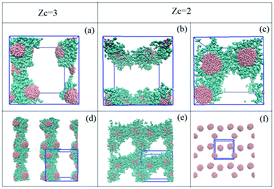Self-assembly of polyelectrolyte diblock copolymers at monovalent and multivalent counterions
Abstract
In this work, the self-assembly behaviors of diblock copolymers consisting of one hydrophobic block and one ionizable polyelectrolyte (PE) block in the presence of monovalent and multivalent counterions are systematically discussed through molecular dynamics simulation. Copolymers are molded as bead-spring chains and the ions are explicitly considered. First, the self-assembled structures of symmetrical block copolymers at different charge fractions are analyzed in detail. Spherical hydrophobic cores are favored by all of the micelles. The effect of counterion valence is much more noticeable at high values of charge fraction. When the PE blocks are fully charged, the presence of multivalent counterions preferably provokes the formation of macroscopic structures. A precipitant spherical micelle is generated in the presence of divalent counterions. Special shapes of coronas are created in the presence of trivalent ions, and a remarkable one dimensional macroscopic cylindrical aggregation of micelles forms; the whole assembly is not typical core–shell micelles, but rather a cylinder with alternating spherical micelles arranged perpendicular to the cylinder axis. The self-assemblies with different lengths of fully charged PE blocks are also discussed. Surprisingly, in the presence of divalent counterions, two dimensional in-plane macroscopic aggregation of micelles is realized when the proportion of PE blocks is larger than 1/2; the self-assembled spherical micelles locate approximately in the same plane to form an inter-linked network. One dimensional aggregation of micelles in the presence of trivalent counterions is maintained with an increased proportion of the PE block. Owing to the dominant intra- and inter-condensation of divalent and trivalent counterions, respectively, two and one dimensional macroscopic aggregation of the micelles is achieved. Our findings indicate that varying the counterion valence is a powerful mechanism to tune the properties of self-assemblies, and the bridging effect introduced by multivalent counterions is the key parameter for the aggregation of the micelles.



 Please wait while we load your content...
Please wait while we load your content...